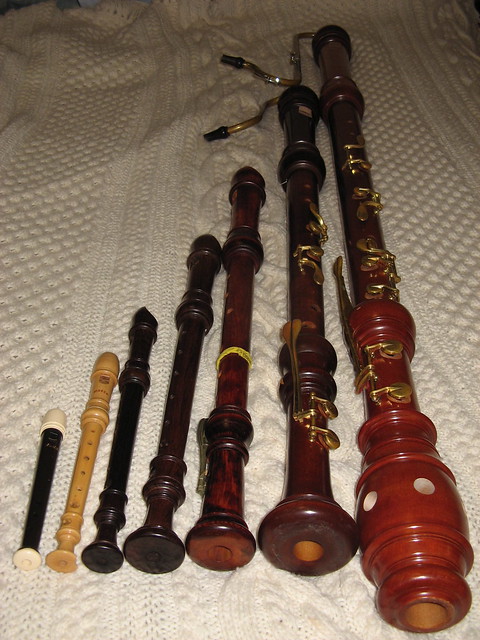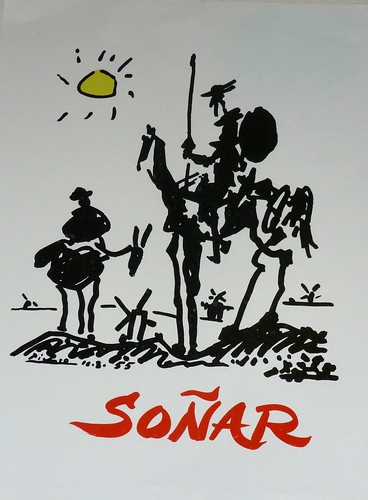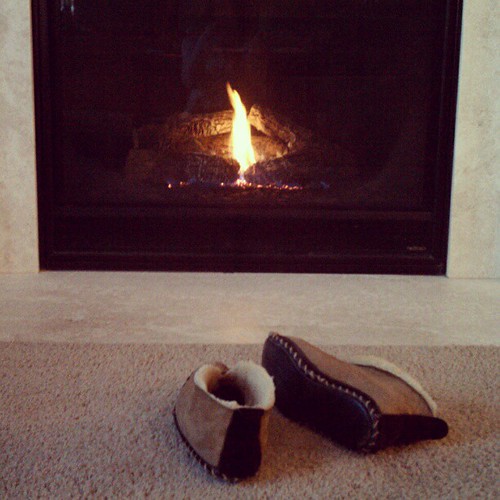Step 1: Acknowledge the nominating blogger:
I so respect Audrey as a reflective teacher. She is passionate about finding the best ways to reach her students and continually adapts her approaches.
Step 2: 11 random facts about me:
1. I am an avid recorder player. I have many recorders from a Garklein (which I never play - it is so high you could attract the dogs from all around) to a great bass which is about my height which is tall for a recorder but not for a person (about 152 cm or almost 5') - the photo below does not show my entire collection!
3. Summer isn't summer without a week at CAMMAC for Early Music Week. I have been attending since 1988.
4. Chocolate is essential to my life. 80% Camino (organic and Fair Trade)
5. My spouse and I often play Boggle. We have changed the rules, playing bilingually (English and French) and don't use a timer.

How many words can you find?
7. I just joined a group that meets once a month to read a Shakespeare play
8.I bought my first computer (a Franklin Ace) and it sat on my desk for 2 weeks before I dared to do anything with it - was afraid I would break it.
9. I became a widow at 32 - it made me grow up fast and change the direction of my life.
10. Have become an avid photographer. I treasure the online relationships that have grown out of my posting on Flickr.
11. Being a single parent has forced me to find my inner strength. Have I made mistakes? Many - but I am proud of whom my children have become even though they have chosen paths that I would not have chosen for them.
Step 3: Answer the nominating blogger's 11 questions:
1. What's the last book you read that had a profound impact on you, personally or professionally - fiction or non-fiction?
Often it's whichever one I am currently reading. I love books that make me want to find out more, that send me to the Internet to explore the subject in greater depth
Fiction lately - Toby's Room did that to me. I love a well-written book.
Mindstorms - many years ago by Seymour Papert left a lasting impression and currently reading Invent to Learn: Making, Tinkering and Engineering in the Classroom
2. What is your number one most-hated-pet-peeve grammar mistake that when you hear it you want to scream? If you can't decide on one, I'd LOVE to hear them all!
It's so fun.
3. How many careers have you had?
I guess about 6 not including Mother
4. Are you the same person face to face as you are online?
4. Are you the same person face to face as you are online?
Mainly yes - though who I am changes with the context - same is true online.
5. What celebrity are you certain you could be good friends with if you ever had the chance?
I'm not at all into celebrity culture - my celebrities are in the Early Music scene and some are already my friends!
6. Everyone says pedagogy first, edtech tool second, but has it ever worked the other way around for you?
I think as I explore edtech tools I think of the pedagogical uses for them - so in that context it is tool first and then pedagogy. But I don't see the point in using a tool just because it is there.
7. What are your desert island foods, record albums, movies? (That only counts as one question.)
Music - a good supply of baroque and renaissance music.
Food - chocolate plus enough healthy food to sustain me. (oh and some coffee would be great)
And I would rather have a big supply of books rather than movies.
8. Who/what always makes you laugh?
That's a tough one - I don't laugh easily.
9. Do you spend any time at all playing something - alone or competing with others?
I spend a lot of time playing music alone and (definitely not competing) with others.
I play in Flutissimo, another large recorder group: Flûtes et companie (I didn't name it!) and a quartet Les Promeneuses. We play occasional concerts.
And Boggle (see above)
10. What was the best professional conference session you ever attended, and what made it the best?
Hmm - I spent a week in Stonington where we played - crickets, programming, microworlds... which led me to take part in two week-long sessions on robotics. Hands on - great teachers/colleagues - playing to learn. One hour conference sessions can be inspiring, but learning takes time.
11. Have you ever watched or heard of the movie Être et Avoir? If not, what do you consider to be the best movie about teaching?
I did see it - I found the teaching a bit too directive. As people they were warm and compassionate. I think that and M. Lazhar both show that it is not always the way you teach that is important (though I am a firm believer in hands on learning), but it is the respect you give to the students that makes them feel they are in a good place for learning.
Step 4: Ask 11 questions:
1. What is something you would really like to learn?
2. If you could live somewhere else - where would it be?
3. What led you to blog?
4. What is your biggest concern about the world today?
5. What brings a smile to your face?
6. What is one way your teaching has changed since you started?
7. What is one piece of advice you would give to a new teacher?
8. What book have you read recently that you would recommend to others?
9. How do you de-stress?
10. What is one place you think everyone should visit?
11. Favourite social media tool?
Step 5: My nominations for 11 bloggers:
Not sure who has already done this. I hope you all don't mind being nominated (again if that's the case), and I truly look forward to reading your responses, if you decide to do this! Please don't feel any pressure - we all have our own priorities!
@colemama
@SSpellmanCann
@kernkelley
@plnaugle
@EHordyskiLuong
@grammasherri
@lparisi
@jenwagner
@langwitches
@kathycassidy
@mariak
5. What celebrity are you certain you could be good friends with if you ever had the chance?
I'm not at all into celebrity culture - my celebrities are in the Early Music scene and some are already my friends!
6. Everyone says pedagogy first, edtech tool second, but has it ever worked the other way around for you?
I think as I explore edtech tools I think of the pedagogical uses for them - so in that context it is tool first and then pedagogy. But I don't see the point in using a tool just because it is there.
7. What are your desert island foods, record albums, movies? (That only counts as one question.)
Music - a good supply of baroque and renaissance music.
Food - chocolate plus enough healthy food to sustain me. (oh and some coffee would be great)
And I would rather have a big supply of books rather than movies.
8. Who/what always makes you laugh?
That's a tough one - I don't laugh easily.
9. Do you spend any time at all playing something - alone or competing with others?
I spend a lot of time playing music alone and (definitely not competing) with others.
I play in Flutissimo, another large recorder group: Flûtes et companie (I didn't name it!) and a quartet Les Promeneuses. We play occasional concerts.
And Boggle (see above)
10. What was the best professional conference session you ever attended, and what made it the best?
Hmm - I spent a week in Stonington where we played - crickets, programming, microworlds... which led me to take part in two week-long sessions on robotics. Hands on - great teachers/colleagues - playing to learn. One hour conference sessions can be inspiring, but learning takes time.
11. Have you ever watched or heard of the movie Être et Avoir? If not, what do you consider to be the best movie about teaching?
I did see it - I found the teaching a bit too directive. As people they were warm and compassionate. I think that and M. Lazhar both show that it is not always the way you teach that is important (though I am a firm believer in hands on learning), but it is the respect you give to the students that makes them feel they are in a good place for learning.
Step 4: Ask 11 questions:
1. What is something you would really like to learn?
2. If you could live somewhere else - where would it be?
3. What led you to blog?
4. What is your biggest concern about the world today?
5. What brings a smile to your face?
6. What is one way your teaching has changed since you started?
7. What is one piece of advice you would give to a new teacher?
8. What book have you read recently that you would recommend to others?
9. How do you de-stress?
10. What is one place you think everyone should visit?
11. Favourite social media tool?
Step 5: My nominations for 11 bloggers:
Not sure who has already done this. I hope you all don't mind being nominated (again if that's the case), and I truly look forward to reading your responses, if you decide to do this! Please don't feel any pressure - we all have our own priorities!
@colemama
@SSpellmanCann
@kernkelley
@plnaugle
@EHordyskiLuong
@grammasherri
@lparisi
@jenwagner
@langwitches
@kathycassidy
@mariak









